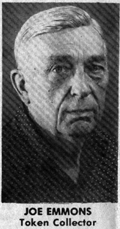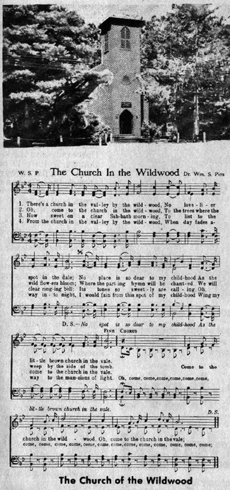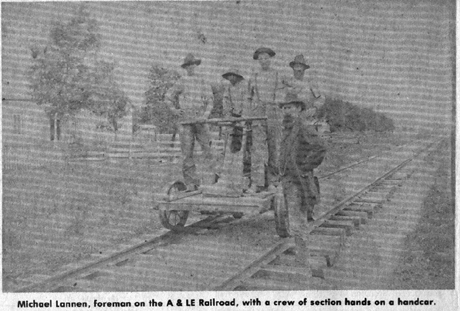July 15, 1982



Picture #1 – Joe Emmons – Token Collector
Picture #2 – The Church of the Wildwood
Picture #3 – Michael Lannen, foreman on the A & LE Railroad, with a crew of section hands on a handcar.
This week’s column is composed of items which had to be omitted from the last two weeks articles, Feedback, and a short note which should interest everyone.
One accompanying photo shows a group of men on a handcar. What is a handcar? Younger readers might not know. The device was used years ago by railroad section-hands to travel along the rails for inspection and repair work.
The car was moved by “muscle-power”. When four men provided the power, it could move quite fast, perhaps 30 miles per hour, according to Bill Richardson my nephew on Leonard Street. A handle on each side of the center was attached to a gear arrangement, which in turn was attached to the wheels. A see-saw movement of the handles put the car in motion. The four flanged wheels on the car fit the rails the same as a regular train car.
Richardson, a retired railroader, told me that many years ago, when he worked for the C & O in southern Ohio, he used a one-man handcar, much like the vehicle used by children, called Irish Mail, on which the rider was seated instead of standing.
In later years, gasoline-powered cars replaced the hand models.
The handcar in the photo was on the A & LE (Atlantic and Lake Erie Railroad) mentioned in last week’s article, which featured the Centennial Home of Joseph Gehring, 612 Cherry St., just north of the railroad.
Michael Lannen, who purchased the house in 1882 is standing beside the handcar. The house had never been lived in when Lannen purchased it. The house is now in the possession of the third generation of the family.
Another photo with today’s article is of Joe Emmons, featured in the July 1 Potluc. He owns a large collection of merchant tokens but is always looking for more. Anyone who own tokens and wished to seel them may write to him: Joe Emmons, 5630 Murray Rd., Hillsboro, Ohio 45133.
CHURCH IN WILDWOOD
Most readers know the old hymn, “The Church in The Wildwood”, but may not know there was an actual church where the song was made famous.
The Little Brown Church in the Vale, Nashua, Iowa, is where the song was first sung in 1864 by Dr. Williams S. Pitts, M.D.
The church was organized in 1855 and built 1860-1864. It is an American shrine, visited by thousands annually, and many make memorable pilgrimages for their sacred wedding ceremony.
The words and music for the song, with this article, will bring back many memories for readers. At the Pontiac Club and also the Lions Club here in town, the song was always a favorite.
FEEDBACK: CENTENNIAL HOME
Joe Gehring reports that many people telephoned him to express their gratitude for the article about his centennial home.
Getrude Kassing, 648 N. Poplar St., telephoned your author as soon as she had read the centennial home article. She reported she had the original abstract for the house she lives in, and it also includes many of the names of those early Fostorians who are named in the article.
GRACE CHURCH OF CHRIST
“Just a note to let you know how much I enjoyed the articles on the history of Grace Church. I have heard many, many favorable comments, not only from the members of Grace Church but from others as well”.
“I enjoyed working with you on these articles and appreciate your time and efforts”. Thank you once again from all the members of Grace Church.
Yours truly, Rev. James W. Garner
From the Rev. Carl Bormuth, named and shown in the church article came this note: “Thanks for the copies of the story about Grace United Church of Christ. It is excellent and I am happy to have it. Of course, I enjoyed all of it but am extremely interest in the part from Rev. E.D. Fager’s historical notes”.
“Rev. Fager was an inspiration to me. His life and words and God speaking through him called me to the ministry”. Thanks again and keep up the good work. Sincerely, Carl